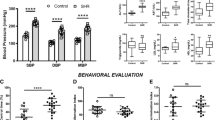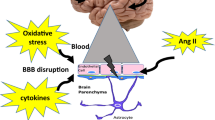Abstract
A causative role of blood-brain barrier (BBB) impairment is suggested in the pathogenesis of vascular dementia with leakage of serum components from small vessels leading to neuronal and glial damage. We examined the BBB function of young adult spontaneously hypertensive rats (SHR) in order to determine earlier changes in the BBB in chronic hypertension. SHR and stroke-prone SHR (SHRSP) were injected with horseradish peroxidase (HRP) as an indicator of BBB function and compared with Wistar Kyoto rats (WKY). The brain tissues were further examined with cationized ferritin, a marker for evaluating glycocalyx. The staining for HRP was distributed around the vessels in the hippocampal fissure of SHR and SHRSP, but not in WKY. With electron microscopy, the extravasated reaction product of HRP appeared in abluminal pits of the endothelial cells of arterioles and within the basal lamina in the hippocampus, but not the cerebral cortex, of SHR and SHRSP. On the contrary, the reaction product of HRP was never seen in the abluminal pits of the endothelial cells or the basal lamina of vessels in WKY. The number of cationized ferritin particles binding to the endothelial cells of capillaries was decreased in the hippocampus of SHR and SHRSP, while the number decreased in the cerebral cortex of SHRSP compared with those in WKY. However, the cationized ferritin binding was preserved in the endothelial cells of the arterioles with an increased vascular permeability. These findings suggest that the chronic hypertensive state induces BBB dysfunction in the hippocampus at an early stage.






Similar content being viewed by others
References
Amano S (1977) Vascular changes in the brain of spontaneously hypertensive rats: hyaline and fibrinoid degeneration. J Pathol 121:119–128
Cavaglia M, Dombrowski SM, Drazba J, Vasanji A, Bokesch PM, Janigro D (2001) Regional variation in brain capillary density and vascular response to ischemia. Brain Res 910:81–93
Cervos-Navarro J, Artigas J, Mrsulja BJ (1983) Morphofunctional aspects of the normal and pathological blood-brain barrier. Acta Neuropathol 8:1-19
Fredriksson K, Auer RN, Kalimo H, Nordborg C, Olsson Y, Johansson BB (1985) Cerebrovascular lesions in stroke-prone spontaneously hypertensive rats. Acta Neuropathol 68:284–294
Fredriksson K, Kalimo H, Westergren I, Kahrstrom J, Johansson BB (1987) Blood-brain barrier leakage and brain edema in the stroke-prone spontaneously hypertensive rats. Acta Neuropathol 74:259–268
Fredriksson K, Kalimo H, Nordborg C, Olsson Y, Johansson BB (1988) Cyst formation and glial response in the brain lesions of stroke-prone spontaneously hypertensive rats. Acta Neuropathol 76:441–450
Fredriksson K, Nordborg C, Kalimo H, Olsson Y, Johansson BB (1988) Cerebral microangiopathy in stroke-prone spontaneously hypertensive rats. An immunohistochemical and ultrastructural study. Acta Neuropathol 75:241–252
Hachinski VC, Potter P, Merskey H (1987) Leuko-araiosis. Arch Neurol 44:21–23
Hazama F, Amano S, Haebara H, Okamoto K (1975) Changes in vascular permeability in the brain of stroke-prone spontaneously hypertensive rats studied with peroxidase as a tracer. Acta Pathol Jap 25:565–574
Johansson BB (1977) The cerebrovascular permeability to protein after bicuculline and amphetamine administration in spontaneously hypertensive rats. Acta Neurol Scand 56:397–404
Johansson BB (1980) The blood-brain barrier in acute and chronic hypertension. Adv Exp Med Biol 131:211–226
Knox CA, Yates RD, Chen I-li, Klara PM (1980) Effects of aging on the structural and permeability characteristics of cerebrovasculature in normotensive and hypertensive strains of rats. Acta Neuropathol 51:1-13
Lindner JR, Ismail S, Spotnitz WD, Skyba DM, Jayaweera AR, Kaul S (1998) Albumin microbubble persistence during myocardial contrast echocardiography is associated with microvascular endothelial glycocalyx damage. Circulation 98:2187–2194
Mesulam M-M (1978) Tetramethyl benzidine for horseradish peroxidase neurohistochemistry: a non-carcinogenic blue reaction-product with superior sensitivity for visualizing neural afferents and efferents. J Histochem Cytochem 26:106–117
Miyamoto M, Kiyota Y, Yamazaki N, Nagaoka A, Matsuo T, Nagawa Y, Takeda T (1986) Age-related changes in learning and memory in the senescence-accelerated mouse (SAM). Physiol Behav 38:399–406
Mueller SM (1982) The blood-brain barrier in young spontaneously hypertensive rats. Acta Neurol Scand 65:623–628
Nag S (1984) Cerebral endothelial surface charge in hypertension. Acta Neuropathol 63:276–281
Negishi H, Ikeda K, Nara Y, Yamori Y (2001) Increased hydroxyl radicals in the hippocampus of stroke-prone spontaneously hypertensive rats during transient ischemia and recirculation. Neurosci Lett 306:206–208
Ogata J, Fujishima M, Tamaki K, Nakatomi Y, Ishitsuka T, Omae T (1981) Vascular changes underlying cerebral lesions in stroke-prone spontaneously hypertensive rats. Acta Neuropathol 54:183–188
Okamoto K, Aoki K (1963) Development of a strain of spontaneously hypertensive rats. Jap Circ J 27:282–293
Okamoto K, Yamori Y, Nagaoka A (1974) Establishment of the stroke-prone spontaneously hypertensive rat (SHR). Circ Res 34:143–153
Parnetti L, Mari D, Mecocci P, Senin U (1994) Pathogenetic mechanisms in vascular dementia. Int J Clin Lab Res 24:15–22
Reese TS, Karnovsky MJ (1967) Fine structural localization of blood-brain barrier to exogenous peroxidase. J Cell Biol 34:207–217
Ritter S, Dinh TT (1986) Progressive postnatal dilatation of brain ventricles in spontaneously hypertensive rats. Brain Res 370:327–332
Roman GC (1996) From UBOs to Binswanger’s disease: impact of magnetic resonance imaging on vascular dementia research. Stroke 27:1269–1273
Sabbatini M, Strocchi P, Vitaioli L, Amenta F (2000) The hippocampus in spontaneously hypertensive rats: A quantitative microanatomical study. Neuroscience 100:251–258
Sabbtini M, Catalani A, Consoli C, Marletta N, Tomassoni D, Avola R (2002) The hippocampus in spontaneously hypertensive rats: an animal model of vascular dementia. Mech Ageing Dev 123:547–559
Schmidt-Kastner R, Szymas J, Hossmann K-A (1990) Immunohistochemical study of glial reaction and serum-protein extravasation in relation to neuronal damage in the rat hippocampus after ischemia. Neuroscience 38:527–540
Shinnou M, Ueno M, Sakamoto H, Ide M (1998) Blood-brain barrier damage in reperfusion following ischemia in the hippocampus of the Mongolian gerbil brain. Acta Neurol Scand 98:406–411
Takeda T, Hosokawa M, Takeshita S, Irino M, Higuchi K, Matsushita T, Tomita Y, Yasuhira K, Hanamoto H, Shimizu K, Ishii M, Yamamuro T (1981) A new murine model of accelerated senescence. Mech Ageing Dev 17:183–194
Thurauf N, Dermietzel R, Kalweit P (1983) Surface charges associated with fenestrated brain capillaries. I. In vitro labeling of anionic sites. J Ultrastruct Res 84:103–110
Ueno M, Akiguchi I, Hosokawa M, Yagi H, Takemura M, Kimura J, Takeda T (1994) Accumulation of blood-borne horseradish peroxidase in medial portions of the mouse hippocampus. Acta Neurol Scand 90:400–404
Ueno M, Akiguchi I, Hosokawa M, Shinnou M, Sakamoto H, Takemura M, Higuchi K (1997) Age-related changes in the brain transfer of blood-borne horseradish peroxidase in the hippocampus of senescence-accelerated mouse. Acta Neuropathol 93:233–240
Ueno M, Akiguchi I, Hosokawa M, Kotani H, Kanenishi K, Sakamoto H (2000) Blood-brain barrier permeability in the periventricular areas of the normal mouse brain. Acta Neuropathol 99:385–392
Ueno M, Sakamoto H, Kanenishi K, Onodera M, Akiguchi I, Hosokawa M (2001) Ultrastructural and permeability features of microvessels in the hippocampus, cerebellum and pons of senescence-accelerated mice (SAM). Neurobiol Aging 22:469–478
Ueno M, Tomimoto H, Akiguchi I, Wakita H, Sakamoto H (2002) Blood-brain barrier disruption in white matter of chronic cerebral hypoperfusion. J Cereb Blood Flow Metab 22:97–104
Vorbrodt AW, Lossinsky AS, Dobrogowska DH, Wisniewski HM (1986) Distribution of anionic sites and glycoconjugates on the endothelial surfaces of the developing blood-brain barrier. Dev Brain Res 29:69–79
Wallin A, Blennow K (1993) Heterogeneity of vascular dementia: mechanisms and subgroups. J Geriatr Psychiatr Neurol 6:177–188
Wardlaw JM, Sandercock PAG, Dennia MS, Starr J (2003) Is breakdown of the blood-brain barrier responsible for lacunar stroke, leukoaraiosis, and dementia? Stroke 34:806–812
Westergaard RD, Brightman MW (1973) Transport of proteins across normal cerebral arterioles. J Comp Neurol 152:17–44
Yamori Y, Horie R, Sato M, Sasagawa S, Okamoto K (1975) Experimental studies on the pathogenesis and prophylaxis of stroke-prone spontaneously hypertensive rats (SHR). (1) Quantitative estimation of cerebrovascular permeability. Jpn Circ J 39:611–615
Yoshida T, Tanaka M, Okamoto K (2002) Immunoglobulin G induces microglial superoxide production. Neurol Res 24(4): 361–364
Acknowledgements
The authors wish to express their appreciation to Ms. C. Ishikawa for technical assistance and to Ms. Y. Fujiwara for editorial assistance. This research was supported by a budget from the Ministry of Education, Culture, Sports, Science and Technology, Japan.
Author information
Authors and Affiliations
Corresponding author
Rights and permissions
About this article
Cite this article
Ueno, M., Sakamoto, H., Tomimoto, H. et al. Blood-brain barrier is impaired in the hippocampus of young adult spontaneously hypertensive rats. Acta Neuropathol 107, 532–538 (2004). https://doi.org/10.1007/s00401-004-0845-z
Received:
Revised:
Accepted:
Published:
Issue Date:
DOI: https://doi.org/10.1007/s00401-004-0845-z




